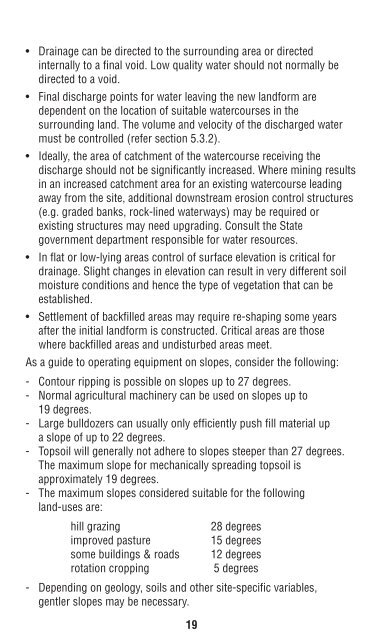Mine Rehabilitation Handbook - Mining and Blasting
Mine Rehabilitation Handbook - Mining and Blasting
Mine Rehabilitation Handbook - Mining and Blasting
You also want an ePaper? Increase the reach of your titles
YUMPU automatically turns print PDFs into web optimized ePapers that Google loves.
• Drainage can be directed to the surrounding area or directed<br />
internally to a final void. Low quality water should not normally be<br />
directed to a void.<br />
• Final discharge points for water leaving the new l<strong>and</strong>form are<br />
dependent on the location of suitable watercourses in the<br />
surrounding l<strong>and</strong>. The volume <strong>and</strong> velocity of the discharged water<br />
must be controlled (refer section 5.3.2).<br />
• Ideally, the area of catchment of the watercourse receiving the<br />
discharge should not be significantly increased. Where mining results<br />
in an increased catchment area for an existing watercourse leading<br />
away from the site, additional downstream erosion control structures<br />
(e.g. graded banks, rock-lined waterways) may be required or<br />
existing structures may need upgrading. Consult the State<br />
government department responsible for water resources.<br />
• In flat or low-lying areas control of surface elevation is critical for<br />
drainage. Slight changes in elevation can result in very different soil<br />
moisture conditions <strong>and</strong> hence the type of vegetation that can be<br />
established.<br />
• Settlement of backfilled areas may require re-shaping some years<br />
after the initial l<strong>and</strong>form is constructed. Critical areas are those<br />
where backfilled areas <strong>and</strong> undisturbed areas meet.<br />
As a guide to operating equipment on slopes, consider the following:<br />
- Contour ripping is possible on slopes up to 27 degrees.<br />
- Normal agricultural machinery can be used on slopes up to<br />
19 degrees.<br />
- Large bulldozers can usually only efficiently push fill material up<br />
a slope of up to 22 degrees.<br />
- Topsoil will generally not adhere to slopes steeper than 27 degrees.<br />
The maximum slope for mechanically spreading topsoil is<br />
approximately 19 degrees.<br />
- The maximum slopes considered suitable for the following<br />
l<strong>and</strong>-uses are:<br />
hill grazing 28 degrees<br />
improved pasture 15 degrees<br />
some buildings & roads 12 degrees<br />
rotation cropping 5 degrees<br />
- Depending on geology, soils <strong>and</strong> other site-specific variables,<br />
gentler slopes may be necessary.<br />
19<br />
5.3 Erosion Control<br />
Control of erosion is important, both during mining <strong>and</strong> rehabilitation.<br />
The effects of erosion may require remedial works on sites where soil<br />
loss has occurred as well as where the material is deposited as drift,<br />
dust or river sediment. Inadequate control of erosion can lead to a<br />
reduction in water quality downstream. A major objective of most<br />
rehabilitation programs is to establish an adequate cover of vegetation<br />
so as to stabilise the site <strong>and</strong> prevent or control erosion to natural levels.<br />
Until a vegetation cover has been established, provision to protect<br />
against wind <strong>and</strong> water erosion will be required.<br />
5.3.1 Wind Erosion<br />
The areas most susceptible to wind erosion are coastal dune systems<br />
<strong>and</strong> semi-arid or arid regions; however, much wider areas are potentially<br />
at risk. The major impact of wind erosion is to reduce the productivity of<br />
the soil <strong>and</strong> create a dust nuisance. Although wind eroded material can<br />
be moved large distances, the majority is usually deposited locally in<br />
drifts across roads <strong>and</strong> against fences <strong>and</strong> buildings.<br />
A vegetation cover is the best long-term means of protecting against<br />
wind erosion. While a vegetation cover is being established, there are<br />
three basic methods of controlling wind erosion on disturbed soils. All<br />
aim to reduce the wind velocity near the soil surface. They are:<br />
• Protection of the soil surface by natural or manufactured materials<br />
or mulch.<br />
In most cases, the use of these materials may form an integral part of<br />
the revegetation program, the aim of which is to establish a permanent<br />
protective cover. Suitable mulch materials are discussed in section<br />
5.5.1. Selection of the mulch will need to consider the following:<br />
- availability of material, particular attention should be paid to using<br />
wastes or by-products which require disposal <strong>and</strong> which might be<br />
available at low cost;<br />
- proposed method seeding or planting which may be integrated<br />
with the application of mulch (hydromulching etc);<br />
- future trafficking of the area - rock mulch or similar resistant<br />
material may be necessary if total exclusion of traffic is not<br />
possible; <strong>and</strong><br />
20
















